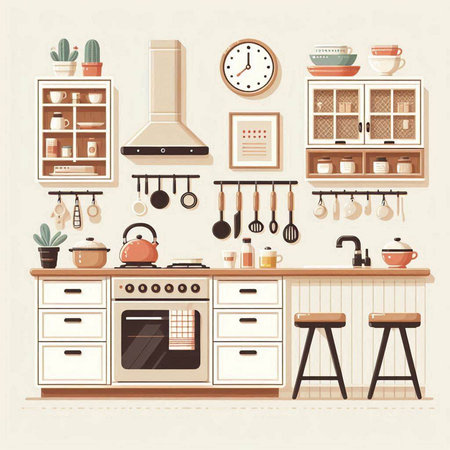Embracing Heritage: The Enduring Allure of Georgian Architecture
British architecture is steeped in a legacy that continues to inspire and captivate, and nowhere is this more evident than in the enduring appeal of Georgian homes. Renowned for their symmetrical façades, elegant sash windows, and intricate cornicing, these period properties embody a sense of refined order and classical beauty. It’s this very sense of proportion and detail that makes them an ideal backdrop for today’s maximalist interiors—a style that thrives on abundance, layering, and personality. In the context of British design, Georgian features offer a sophisticated framework upon which bold colours, eclectic collections, and rich textiles can be artfully layered. The grand yet restrained architecture allows homeowners to push creative boundaries without overwhelming the space. Ornate mouldings frame dramatic wallpapers, while high ceilings invite statement lighting and gallery walls. Thus, the timeless characteristics of Georgian homes are not only preserved but celebrated, providing an elegant canvas where heritage meets the exuberance of contemporary maximalism.
2. Victorian Influences: Layered Decor and Ornate Detailing
The Victorian era, spanning from the mid-19th to early 20th century, remains one of Britain’s most influential periods for interior architecture and design—especially for those drawn to maximalism. Unlike the restrained elegance of Georgian style, Victorian homes embraced a philosophy of “more is more,” transforming interiors into richly decorated sanctuaries filled with personality and history. This era’s love for decorative features, sumptuous colour palettes, and an abundance of textiles aligns perfectly with the core tenets of maximalist design.
Rich Colour Palettes and Patterns
Victorian interiors are synonymous with bold, dramatic colours—deep greens, rich burgundies, sapphire blues, and regal golds were favoured on walls, upholstery, and drapery. These saturated tones create a sense of warmth and intimacy that maximalists crave. Walls often featured elaborate wallpapers with intricate florals or damasks, layered over wooden panelling or ornate cornices. The result? A visual feast of colour and pattern that provides endless opportunities for layering within a space.
Abundant Textiles: From Velvet to Tapestry
Textiles played a starring role in Victorian design. Heavy velvet curtains, tasselled trims, embroidered cushions, and Persian-style rugs added luxurious texture to every room. Maximalists can take cues from this approach by mixing fabrics—juxtaposing velvet with silk, tapestry with lace—to create tactile richness. The layering of textiles not only enhances comfort but also echoes the British tradition of collecting objects and stories over time.
Decorative Features: The Art of Ornamentation
No detail was too small to be embellished in a Victorian home. Intricately carved woodwork, gilded mirrors, stained glass panels, and elaborate ceiling roses became signatures of the era. These features offer inspiration for today’s maximalist spaces by encouraging the celebration of craftsmanship and ornamentation. Pairing such elements with contemporary art or modern lighting creates tension and drama—a hallmark of British maximalism.
Victorian vs. Maximalist Approaches
| Victorian Feature | Maximalist Adaptation |
|---|---|
| Ornate mouldings & cornices | Retain period details; layer with bold artwork |
| Heavy drapes & layered textiles | Mix historic fabrics with modern prints |
| Saturated wall colours & patterned wallpapers | Combine multiple patterns in one space; embrace colour clashes |
| Curated collections (china, books) | Display diverse collections on open shelving or gallery walls |
The Enduring Appeal in British Homes
The enduring popularity of Victorian influences in British interiors lies in their ability to tell a story through layers—whether it’s inherited heirlooms or newly discovered treasures. By honouring this heritage while embracing maximalism’s freedom to mix eras and styles, designers create homes brimming with individuality and vibrant energy—a true reflection of Britain’s evolving aesthetic legacy.

3. Edwardian Adaptations: Light, Airy Spaces Meet Bold Expression
The Edwardian era brought a welcome shift in British domestic architecture, moving away from the ornate darkness of the Victorian period and embracing generous proportions, light-filled rooms, and an unmistakably airy ambiance. Hallmarks such as wide hallways, high ceilings, and expansive bay windows became the signature of Edwardian homes, inviting both sunlight and a sense of openness that feels remarkably modern even today.
These architectural features serve as a perfect canvas for maximalism. The ample wall space and lofty interiors provide the freedom to layer statement wallpapers, hang oversized artworks, or install dramatic light fittings without overwhelming the room. Bay windows, so characteristic of the Edwardian style, naturally draw the eye and create alcoves ideal for bold seating arrangements or vibrant window treatments—think jewel-toned velvets or exuberant patterned drapery that frame garden views.
Edwardian palettes also tended towards lighter hues—soft creams, delicate pastels, and gentle greys—which offer a subtle backdrop against which maximalist accessories can shine. This neutrality allows for playful experimentation with colour and texture: plush rugs in vivid patterns can be layered on original parquet floors; collections of ceramics or curios can be artfully displayed along picture rails or within glass-fronted cabinets; and bold contemporary furnishings can sit comfortably beside heritage detailing like decorative cornices or wooden panelling.
Ultimately, it is this adaptability that makes Edwardian architecture so suited to maximalist expression. The balance between lightness and volume means spaces never feel cramped or cluttered, no matter how adventurous the décor. Instead, each element—from statement lighting to eclectic objets d’art—becomes part of a harmonious whole that celebrates both historic character and personal creativity within a quintessentially British framework.
4. Modern British Extensions: Fusing Old and New in Open Spaces
Across the UK, homeowners are increasingly embracing contemporary extensions to breathe new life into traditional Georgian, Victorian, and Edwardian homes. These modern additions—often featuring bold glass walls, skylights, and open-plan layouts—create a striking juxtaposition between period features and current-day living. The trend towards “glass-kissed” extensions is not just about architectural bravado; it’s about inviting more of Britain’s elusive natural light indoors, transforming previously compartmentalised spaces into vibrant hubs for maximalist expression.
The Role of Glass and Light in Maximalist Interiors
British weather may be famously unpredictable, but large panes of glass and cleverly designed rooflights mean sunlight can be harnessed throughout the year. For maximalists, this abundance of daylight is a game changer. It allows jewel tones, layered textiles, and curated displays to glow in natural brilliance rather than recede into shadowy corners. Even on a rainy London afternoon or misty Yorkshire morning, light bounces off glossy finishes, eclectic art collections, and punchy wallpapers, animating each detail with energy.
Comparing Classic and Contemporary Elements in British Homes
| Feature | Traditional British Home | Contemporary Extension |
|---|---|---|
| Windows | Sash windows with small panes | Floor-to-ceiling glass panels & bi-fold doors |
| Layout | Separate rooms (parlour, dining room) | Open-plan kitchen/dining/living zones |
| Lighting | Fireplaces and lamps | Maximised natural light & skylights |
| Decor Display | Limited wall space for art/objects | Expansive walls & flexible shelving for collections |
The Maximalist Advantage: Curate Without Restraint
This fusion of old and new gives maximalists unprecedented freedom. Walls that once divided now dissolve into flowing zones where statement furniture sits comfortably against period cornices and contemporary glass. Collections can be rotated seasonally or expanded without constraint. Bold patterns are no longer lost in gloom; instead, they’re illuminated by shafts of sunlight darting across parquet floors or terrazzo tiles. The result is an unapologetically British style—rooted in heritage yet unafraid to evolve—that celebrates both nostalgia and novelty in equal measure.
5. The Maximalist Mindset: British Eccentricity and Collecting Spirit
Britain’s love affair with maximalism is more than a fleeting trend—it is deeply woven into the nation’s cultural fabric. From the Georgian penchant for displaying curiosities to the Victorian obsession with ornate parlours, the British have long embraced an eclectic, layered approach to interiors. This celebrated fondness for collecting is not simply about amassing objects; it is a joyful exercise in storytelling, where every artefact, painting, or inherited trinket serves as a chapter in a personal narrative.
The Art of Layering
In traditional British homes, architectural features such as deep skirting boards, intricate cornices, and generous bay windows create a canvas primed for maximalist expression. These period details invite homeowners to layer patterns, textures, and colours without overwhelming the senses. Velvet drapes frame sash windows, while gilded mirrors bounce light across ornately papered walls—a harmonious cacophony that feels both curated and lived-in.
Storytelling Through Space
Maximalism in Britain thrives on the belief that more is more—yet there is an unmistakable method to this madness. The architecture of old townhouses or country cottages, with their alcoves, nooks, and grand mantels, encourages the display of collected treasures. Each vignette becomes a visual tale: porcelain tea sets recalling family gatherings, antique maps hinting at wanderlust, or contemporary art sparking dialogue amid tradition. The result is a home that reads like a well-thumbed novel—rich in history, memory, and personality.
A Celebration of Abundance
This collecting spirit finds its perfect stage in British architecture. High ceilings allow statement chandeliers and towering bookcases; panelled walls host dense picture galleries; original fireplaces become shrines to eccentric arrangements. In every corner lies an invitation to celebrate abundance—not just of things but of stories, experiences, and identities. Ultimately, it is this spirited embrace of individuality and nostalgia that makes maximalism feel so distinctly at home within Britain’s most cherished architectural forms.
6. Styling Maximalism: Practical Tips for British Homes
Embracing maximalism within British architectural contexts—from stately Georgian townhouses to sleek contemporary flats—requires a thoughtful approach to layering, scale, and respect for period features. Here’s how to infuse your UK home with bold personality while honouring its unique heritage.
Layer Patterns with Purpose
Start by selecting a unifying colour palette that echoes your home’s architectural details, such as cornicing, dado rails, or original fireplaces. Layer florals, stripes, and damasks in textiles and wallpapers to create visual intrigue without overwhelming the senses. In Georgian or Victorian spaces, opt for classic motifs updated in contemporary hues; in modern builds, experiment with oversized abstracts or graphic prints for contrast.
Balance Scale and Proportion
British rooms often feature high ceilings and large windows—or conversely, charmingly compact nooks. Use scale to your advantage: in grander spaces, introduce statement lighting or expansive rugs to anchor maximalist schemes. For cosier terraces or flats, mix small-scale patterns and slimline furnishings to avoid clutter while maintaining depth and richness.
Curate Gallery Walls with Character
Gallery walls are quintessentially British and perfectly suited to maximalist expression. Curate an eclectic mix of artworks, vintage mirrors, and framed memorabilia. Let picture rails guide your arrangement in period homes; in new-builds, go floor-to-ceiling for impact. Choose frames in varying finishes—gilt, wood, lacquer—for a collected-over-time feel that reflects both personal history and place.
Respect Period Features Amid Bold Design Choices
Maximalism should enhance—not obscure—the architectural story of your home. Highlight original mouldings with contrasting wall colours or patterned wallpaper panels set within them. Retain exposed brickwork or wooden beams as textural counterpoints to vibrant upholstery and accessories. If you’re updating a listed property, use removable décor elements like rugs, cushions, or art so you can refresh the look without compromising protected features.
Mix Old and New Thoughtfully
Bespoke maximalism flourishes when heirloom pieces sit alongside contemporary finds. Pair antique sideboards with geometric ceramics; set mid-century chairs against ornate skirting boards. This blend pays homage to Britain’s layered design history while keeping interiors dynamic and deeply personal.
Final Touches: Make It Your Own
No two maximalist spaces should feel identical—especially in the context of Britain’s diverse housing stock. Whether you’re styling a Regency crescent flat or a post-war semi-detached, let local craftsmanship, inherited treasures, and fearless pattern play steer your scheme. Maximalism in British homes is ultimately about confidence: celebrating what’s beautiful in abundance while honouring the bones of the building itself.


